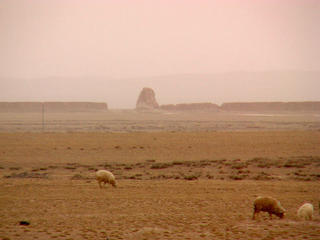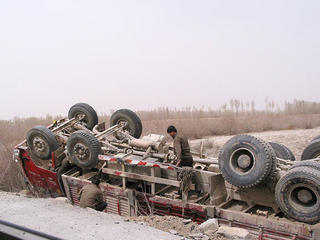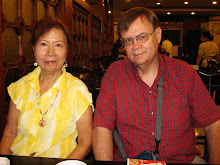Silk Road Adventure: Day 4 Wuwei to Jaruguan
 We left Wuwei in the early morning hours and headed out on a super highway (costs money, of course) across Gansu Province. This area is called the Hexi Corredor and was just about the only way to get to the western lands of Chinese Turkistan. The sites are monotonous and the towns are few and far apart. We stopped now and then to take on fuel and to take breaks. .
We left Wuwei in the early morning hours and headed out on a super highway (costs money, of course) across Gansu Province. This area is called the Hexi Corredor and was just about the only way to get to the western lands of Chinese Turkistan. The sites are monotonous and the towns are few and far apart. We stopped now and then to take on fuel and to take breaks. .  I had planned to stop in Zangye, about halfway between Wuwei and our final destination of the day, Jaruguan. It is 235 KM from Wuwei. AS we approached Zangye, we began to see the remnants of the Great Wall. Small and distant and first but as we approached the Zangye area, we got closer and closer to it. The color of the Great Wall matched its environment, reddish brown.
I had planned to stop in Zangye, about halfway between Wuwei and our final destination of the day, Jaruguan. It is 235 KM from Wuwei. AS we approached Zangye, we began to see the remnants of the Great Wall. Small and distant and first but as we approached the Zangye area, we got closer and closer to it. The color of the Great Wall matched its environment, reddish brown. The wall was pretty beat up but one could still see the evidence that at one time it was very substantial. We stopped often for me to take pictures as we got closer and closer to it. We began to feel we were indeed approaching China's frontier. It was a wild and desolate land with very little evidence of human inhabitants except the highway and its supporting elements. I was feeling excitement. Here was the edge of old China and we were going to drive right through the Great Wall! We eventually did shoot through a hug hole in the Great Wall but it happened so fast that I was not able to record it in my digital camera. Because we had to come back this way, I made a mental note to stop on the way back.
The wall was pretty beat up but one could still see the evidence that at one time it was very substantial. We stopped often for me to take pictures as we got closer and closer to it. We began to feel we were indeed approaching China's frontier. It was a wild and desolate land with very little evidence of human inhabitants except the highway and its supporting elements. I was feeling excitement. Here was the edge of old China and we were going to drive right through the Great Wall! We eventually did shoot through a hug hole in the Great Wall but it happened so fast that I was not able to record it in my digital camera. Because we had to come back this way, I made a mental note to stop on the way back. 
 China has very little regulations controlling the big trucks that move along her highways. We often saw trucks that were overloaded and overweight. This particular truck flipped when the road under construction did not allow it to make a sharp turn to the left. Other trucks were carefully making the turn and finding the same inertial problem. We slipped by this mess and I was able to get a photo of the truck.
China has very little regulations controlling the big trucks that move along her highways. We often saw trucks that were overloaded and overweight. This particular truck flipped when the road under construction did not allow it to make a sharp turn to the left. Other trucks were carefully making the turn and finding the same inertial problem. We slipped by this mess and I was able to get a photo of the truck. Upon reaching Zhangye, we Immediately saw The Wooden Pagoda Temple in the downtown area. It was built in around 557-588 A.D. during the early Northern Zhou Dynasty. The pagoda had been renovated several times during the dynasties of Sui (581-618A.D.), the Tang (618-907 A.D.), the Ming (1368-1644 A.D.) and the Qing (1644-1911 A.D.). The Wooden Pagoda looked to be in great shape. It is regarded as one of Zhangye City's "Five Elements" Pagodas. (Metal, wood, water, fire and earth are the "five elements" in ancient Chinese philosophy and fortune-telling.).
Upon reaching Zhangye, we Immediately saw The Wooden Pagoda Temple in the downtown area. It was built in around 557-588 A.D. during the early Northern Zhou Dynasty. The pagoda had been renovated several times during the dynasties of Sui (581-618A.D.), the Tang (618-907 A.D.), the Ming (1368-1644 A.D.) and the Qing (1644-1911 A.D.). The Wooden Pagoda looked to be in great shape. It is regarded as one of Zhangye City's "Five Elements" Pagodas. (Metal, wood, water, fire and earth are the "five elements" in ancient Chinese philosophy and fortune-telling.).The pagoda is a nine-storey building with a height of around 108 feet. It has a unique octagon shaped structure in each tier with eight dragonhead woodcarvings in each angle, a bead in the mouth, and a wind-bell below the neck. The main body is made of wood with eaves formed into pavilion style structure. Within the pagoda, each floor has doors, cloisters, engraved windows and lintels, which were embedded with brick carved steles. It is extremely unique from other pagodas because neither a nail nor a rivet can be found in the entire structure. The pagoda is beautiful and magnificent.
 The main attraction at Zhangye is the temple which houses the largest Buddha image in all of China. Since I was the only one interested in this site, I was the only one to pay money to see it. My wife figured she has seen enough big buddhas to last a lifetime. The money, in my opinion, was well spent. I must have taken a hundred photos of the temple compound eventhough I was not allowed to take pictures of the actual reclining giant Buddha.
The main attraction at Zhangye is the temple which houses the largest Buddha image in all of China. Since I was the only one interested in this site, I was the only one to pay money to see it. My wife figured she has seen enough big buddhas to last a lifetime. The money, in my opinion, was well spent. I must have taken a hundred photos of the temple compound eventhough I was not allowed to take pictures of the actual reclining giant Buddha. The entrance to the temple was impressive, maybe because it did not feel as if it was a commerical venture. The buildings inside were not well kept and the actual building holding the giant Buddha was magnificent! My understanding is that this is the last of the really great Buddhist temples still standing which were originally built of hand carved wood.
The entrance to the temple was impressive, maybe because it did not feel as if it was a commerical venture. The buildings inside were not well kept and the actual building holding the giant Buddha was magnificent! My understanding is that this is the last of the really great Buddhist temples still standing which were originally built of hand carved wood.  This Giant Buddha Temple is the largest architectural relic in Gansu Province and was built during the Western Xia (1038-1227) period. This large reclining Buddha appeared to be fairly well preserved in the main wooden temple.
This Giant Buddha Temple is the largest architectural relic in Gansu Province and was built during the Western Xia (1038-1227) period. This large reclining Buddha appeared to be fairly well preserved in the main wooden temple. Legend has it that a chancellor named Wei Mie of the Western Xia period ordered workers to dig into the ground to 1 to 1.3 meters deep to carve a reclining Buddha to be covered with glazed color tiles. The Giant Buddha Temple was built in 1098 to house the Buddha. In its 900 years the temple was restored many times during the Ming and Qing dynasties.
 The existing complex consists of the Giant Buddha Hall, the Buddhist Classics Hall, and a Clay Pagoda. The two-storied Giant Buddha Hall is 33 meters high, 49 meters wide and 24 meters long, with a total area of 1770 square meters. The gold-plated and painted Giant Buddha lies in the Nirvana situation in the middle of the hall. The whole Buddha is 34.5 meters long and 7.5 meters wide between its two shoulders, with feet of 4 meters and ears of 2 meters. The Buddha's calm expression moves visitors. Behind the Buddha are 10 disciples, and in two side halls stand 18 Saintly Warriors. The walls of the hall are covered with colorful murals, which depict episodes from the Mountain-sea Sutra (an ancient Chinese encyclopedia) and from Journey to the West (a celebrated novel written in the Ming Dynasty).
The existing complex consists of the Giant Buddha Hall, the Buddhist Classics Hall, and a Clay Pagoda. The two-storied Giant Buddha Hall is 33 meters high, 49 meters wide and 24 meters long, with a total area of 1770 square meters. The gold-plated and painted Giant Buddha lies in the Nirvana situation in the middle of the hall. The whole Buddha is 34.5 meters long and 7.5 meters wide between its two shoulders, with feet of 4 meters and ears of 2 meters. The Buddha's calm expression moves visitors. Behind the Buddha are 10 disciples, and in two side halls stand 18 Saintly Warriors. The walls of the hall are covered with colorful murals, which depict episodes from the Mountain-sea Sutra (an ancient Chinese encyclopedia) and from Journey to the West (a celebrated novel written in the Ming Dynasty).The Clay Pagoda, one of the Five Elements Pagodas in Zhangye, has 13 stories, on the first and the second stories of which are four miniature pagodas, a feature rarely seen in other pagodas.
 In the Buddhist Classics Hall, there are more than 6000 tomes of lectures, some of which, written in gold and silver, are the rarest and most precious.
In the Buddhist Classics Hall, there are more than 6000 tomes of lectures, some of which, written in gold and silver, are the rarest and most precious. It is said that the Bieji Queen (a famous queen of the Yuan Dynasty) once lived in the Giant Buddha Temple, giving birth to Kublai Khan there. The Italian traveler Marco Polo, impressed by the magnificent architecture of the Giant Buddha Temple and by the prosperity of Zhangye city, lived here for more than a year.
We finally got back on the road in late afternoon (around 3PM) and stopped at our destination of Jaruguan 251 KM away. The scenery was exactly as it had been prior to Zhangye except the Great Wall was on the left and gradually disappearing on the horizon.


0 Comments:
Post a Comment
<< Home